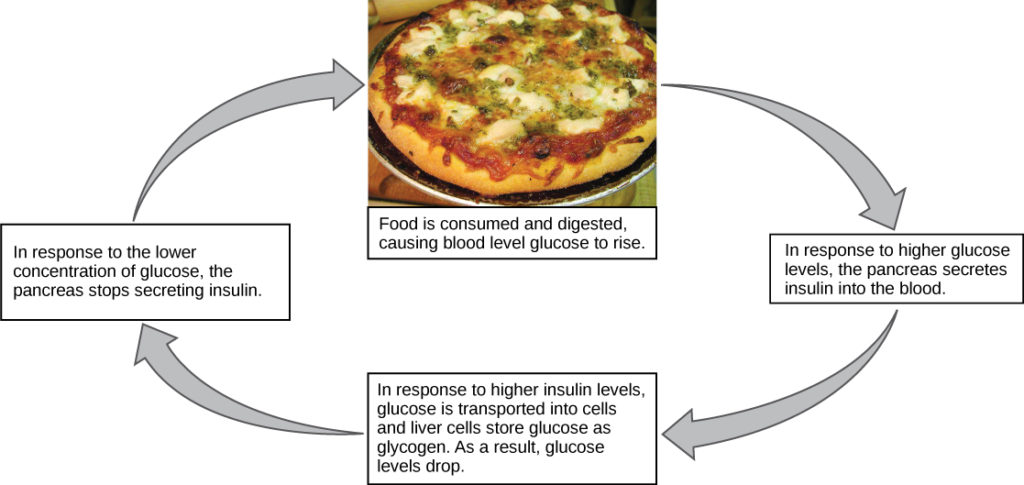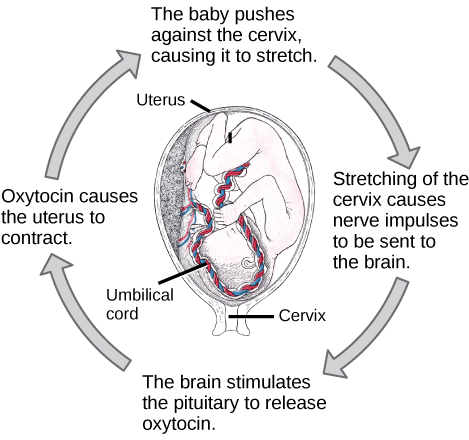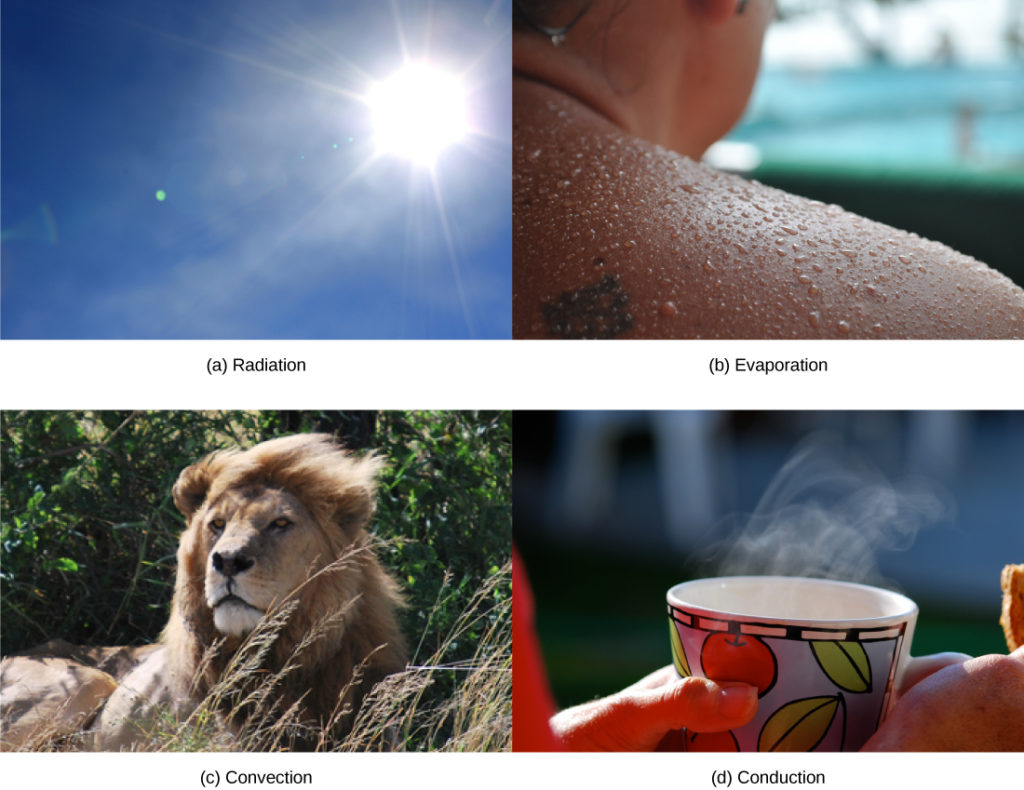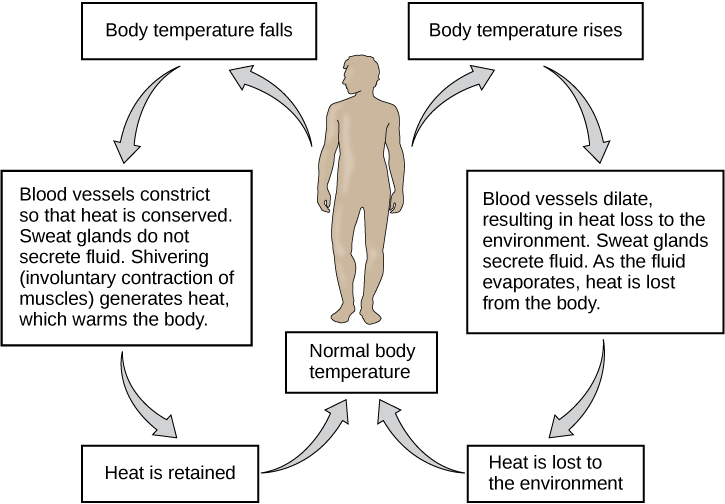Learning Objectives
By the end of this section, you will be able to:
- Define homeostasis
- Discuss positive and negative feedback mechanisms used in homeostasis
- Describe thermoregulation of endothermic and ectothermic animals
Animal organs and organ systems constantly adjust to internal and external changes through a process called homeostasis (“steady state”). Homeostasis means to maintain dynamic equilibrium in the body. It is dynamic because it is constantly adjusting to the changes that the body’s systems encounter. It is equilibrium because body functions are kept within specific ranges. Even an animal that is apparently inactive is maintaining this homeostatic equilibrium.
Homeostatic Process
The goal of homeostasis is the maintenance of equilibrium around a point or value called a set point. While there are normal fluctuations from the set point, the body’s systems will usually attempt to go back to this point. A change in the internal or external environment is called a stimulus and is detected by a receptor. The response of the system is to adjust the deviation parameter toward the set point. For instance, if the body becomes too warm, adjustments are made for cooling. If the blood’s glucose rises after a meal, adjustments are made to lower the blood glucose level by either getting the glucose to the tissues or storing it for later use.
Control of Homeostasis
When a change occurs in an animal’s environment, an adjustment must occur. The receptor senses the change in the environment, then sends a signal to the control center (in most cases, the brain) which in turn generates a response that is signaled to an effector. The effector is a muscle (that contracts or relaxes) or a gland that secretes a product. Homeostasis is maintained by negative feedback loops. Positive feedback loops actually push the organism further out of homeostasis, but may be necessary for life to occur. Ultimately, homeostasis is controlled by the nervous and endocrine system of mammals.
Negative Feedback Mechanisms
Any homeostatic process that changes the direction of the stimulus is a negative feedback loop. A negative feedback is where the response cancels the stimulus. It may either increase or decrease the stimulus, but the stimulus is not allowed to continue as it did before the receptor sensed it. In other words, if a level is too high, the body does something to bring it down, and conversely, if a level is too low, the body does something to make it go up. Hence the term negative feedback. Blood glucose levels in an animal is an excellent example of this process. When an animal eats, blood glucose levels rise. The nervous system senses this and the pancreas releases the hormone, insulin. Insulin causes blood glucose levels to decrease, as illustrated in Figure 1. However, if an animal has not eaten and blood glucose levels decrease, the pancreas releases glucagon causing glucose levels to increase.

Figure 1. Blood sugar levels are controlled by a negative feedback loop. (credit: modification of work by Jon Sullivan)
Positive Feedback Loop
A positive feedback loop maintains the direction of the stimulus, possibly accelerating it. Few examples of positive feedback loops exist in animals, but one is found in the cascade of chemical reactions resulting in blood clotting, or coagulation. As one clotting factor is activated, it activates the next factor in sequence until a clot is formed. The direction is continusous, not changed, creating a positive feedback. Another example of positive feedback is uterine contractions during childbirth, as illustrated in Figure 2. The hormone, oxytocin ,stimulates the contraction of the uterus. This produces pain sensed by the nervous system. Instead of lowering the oxytocin and causing the pain to subside, more oxytocin is produced until the contractions are powerful enough for the birth of the baby.
Art Connection

State whether each of the following processes is regulated by a positive feedback loop or a negative feedback loop.
- A person feels satiated after eating a large meal.
- The blood has plenty of red blood cells. As a result, erythropoietin, a hormone that stimulates the production of new red blood cells, is no longer released from the kidney.
Set Point
It is possible to adjust a system’s set point. When this occurs, the feedback loop works to maintain the new setting. Blood pressure is an excellent example of set point changes. Over time, the normal or set point for blood pressure can increase as a result of continued increases in blood pressure. The body no longer recognizes the elevation as abnormal and no attempt is made to return to the lower set point. The result is the maintenance of an elevated blood pressure that can have harmful effects on the body. Medication is prescribed to lower blood pressure, thus lowering the set point in the system to a more healthy level. This is called a process of alteration of the set point in a feedback loop.
Acclimatization occurs when changes are made in one organ system in order to maintain a set point in another system. This occurs, for instance, when an animal migrates to a higher altitude than it is accustomed. In order to adjust to the lower oxygen levels at the new altitude, the body increases the number of red blood cells circulating in the blood to ensure adequate oxygen delivery to the tissues. Another example of acclimatization is animals that have seasonal changes in their coats: a heavier coat in the winter ensures adequate heat retention, and a light coat in summer assists in keeping body temperature from rising to harmful levels.
Link to Learning
Feedback mechanisms can be understood in terms of driving a race car along a track: watch a short video lesson on positive and negative feedback loops.
Homeostasis: Thermoregulation
Body temperature affects body activities. Generally, as body temperature rises, enzyme activity rises. For every ten degree centigrade rise in temperature, enzyme activity doubles, up to a point. Body proteins, including enzymes, begin to denature and lose their function with high heat (around 50oC for mammals). Enzyme activity will decrease by half for every ten degree centigrade drop in temperature, to the point of freezing, with a few exceptions. Some fish can withstand freezing solid and return to normal with thawing.
Link to Learning
Watch this Discovery Channel video on thermoregulation to see illustrations of this process in a variety of animals.
https://youtu.be/NJEBfl_LKno
Endotherms and Ectotherms
Animals can be divided into two groups based on thermoregulation. Some animals maintain a constant body temperature in the face of differing environmental temperatures, while others have a body temperature that is the same as their environment and thus varies with the environment. Animals that do not control their body temperature are ectotherms. This group has been called cold-blooded. Endotherms are animals that rely on internal sources for body temperature but can exhibit temperature extremes. These animals are able to maintain a level of activity at cooler temperature due to differing enzyme activity levels.
Heat can be exchanged between an animal and its environment through four mechanisms: radiation, evaporation, convection, and conduction. Radiation is the emission of electromagnetic “heat” waves. Heat comes from the sun in this manner and radiates from dry skin the same way. Heat can be removed with liquid from a surface during evaporation. This occurs when a mammal sweats. Convection currents of air remove heat from the surface of dry skin as the air passes over it. Heat will be conducted from one surface to another during direct contact with the surfaces, such as an animal resting on a warm rock.

Figure 3. Heat can be exchanged by four mechanisms: (a) radiation, (b) evaporation, (c) convection, or (d) conduction. (credit b: modification of work by “Kullez”/Flickr; credit c: modification of work by Chad Rosenthal; credit d: modification of work by “stacey.d”/Flickr)
Neural Control of Thermoregulation
The nervous system is important to thermoregulation, as illustrated in Figure 4. The processes of homeostasis and temperature control are centered in the hypothalamus of the brain.
Art Connection

Figure 4. The body is able to regulate temperature in response to signals from the nervous system.
When bacteria are destroyed by leuckocytes, pyrogens are released into the blood. Pyrogens reset the body’s thermostat to a higher temperature, resulting in fever. How might pyrogens cause the body temperature to rise?
The hypothalamus maintains the set point for body temperature through reflexes that cause vasodilation and sweating when the body is too warm, or vasoconstriction and shivering when the body is too cold. It responds to chemicals from the body. When a bacterium is destroyed by phagocytic leukocytes, chemicals called endogenous pyrogens are released into the blood. These pyrogens circulate to the hypothalamus and reset the thermostat. This allows the body’s temperature to increase in what is commonly called a fever. An increase in body temperature causes iron to be conserved, which reduces a nutrient needed by bacteria. An increase in body heat also increases the activity of the animal’s enzymes and protective cells while inhibiting the enzymes and activity of the invading microorganisms. Finally, heat itself may also kill the pathogen. A fever that was once thought to be a complication of an infection is now understood to be a normal defense mechanism.
Section Summary
Homeostasis is a dynamic equilibrium that is maintained in body tissues and organs. It is dynamic because it is constantly adjusting to the changes that the systems encounter. It is in equilibrium because body functions are kept within a normal range, with some fluctuations around a set point for the processes.
Additional Self Check Questions
B. The blood has plenty of red blood cells. As a result, erythropoietin, a hormone that stimulates the production of new red blood cells, is no longer released from the kidney.
2. When bacteria are destroyed by leuckocytes, pyrogens are released into the blood. Pyrogens reset the body’s thermostat to a higher temperature, resulting in fever. How might pyrogens cause the body temperature to rise?
3. Why are negative feedback loops used to control body homeostasis?
4. Why is a fever a “good thing” during a bacterial infection?
5. How is a condition such as diabetes a good example of the failure of a set point in humans?
Answers
1. Both processes are the result of negative feedback loops. Negative feedback loops, which tend to keep a system at equilibrium, are more common than positive feedback loops.
2. Pyrogens increase body temperature by causing the blood vessels to constrict, inducing shivering, and stopping sweat glands from secreting fluid.
3. An adjustment to a change in the internal or external environment requires a change in the direction of the stimulus. A negative feedback loop accomplishes this, while a positive feedback loop would continue the stimulus and result in harm to the animal.4. Mammalian enzymes increase activity to the point of denaturation, increasing the chemical activity of the cells involved. Bacterial enzymes have a specific temperature for their most efficient activity and are inhibited at either higher or lower temperatures. Fever results in an increase in the destruction of the invading bacteria by increasing the effectiveness of body defenses and an inhibiting bacterial metabolism.
5. Diabetes is often associated with a lack in production of insulin. Without insulin, blood glucose levels go up after a meal, but never go back down to normal levels.
Glossary
acclimatization: alteration in a body system in response to environmental change
alteration: change of the set point in a homeostatic system
homeostasis: dynamic equilibrium maintaining appropriate body functions
negative feedback loop: feedback to a control mechanism that increases or decreases a stimulus instead of maintaining it
positive feedback loop: feedback to a control mechanism that continues the direction of a stimulus
set point: midpoint or target point in homeostasis
thermoregulation: regulation of body temperature
Candela Citations
- Biology. Authored by: Open Stax. Located at: http://cnx.org/contents/185cbf87-c72e-48f5-b51e-f14f21b5eabd@9.17:1/Biology. License: CC BY: Attribution
- Discovery Channel: Thermoregulation in Animals . Authored by: Nisar Ahmad Shah. Provided by: Discovery Channel. Located at: http://youtu.be/NJEBfl_LKno. License: All Rights Reserved. License Terms: Standard YouTube license
- Feedback Loops. Authored by: Johnny Clore. Located at: https://youtu.be/_QbD92p_EVs. License: All Rights Reserved. License Terms: Standard YouTube License